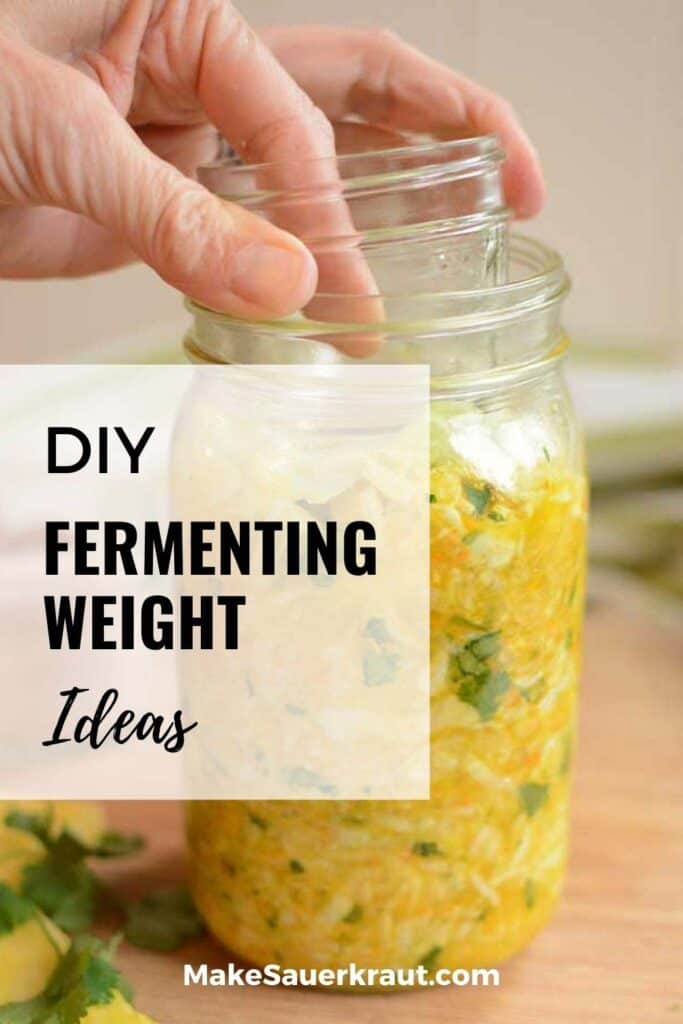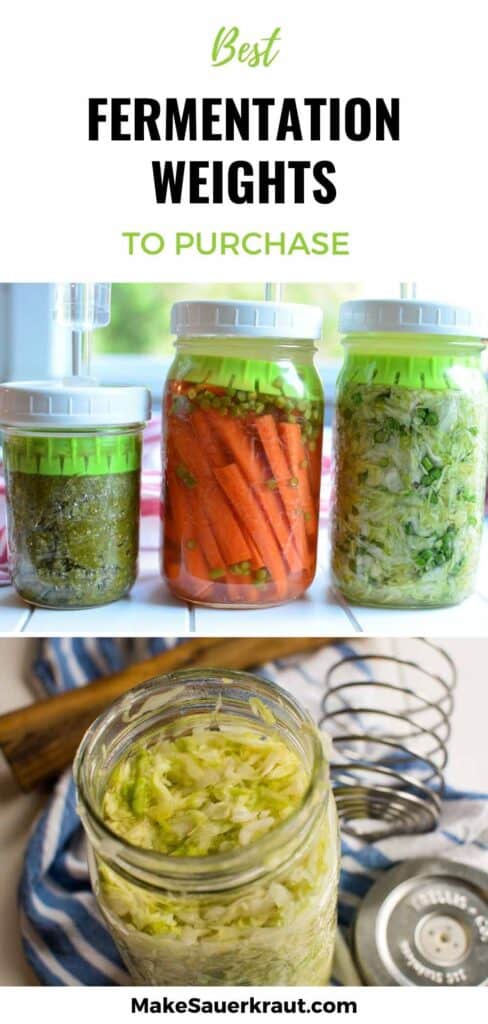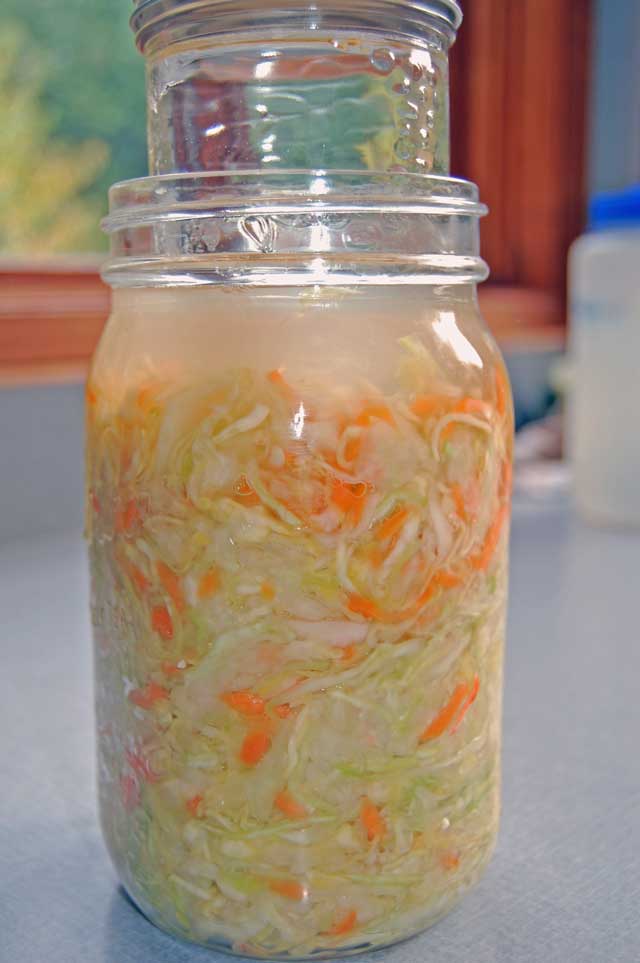Have you ever opened one of your precious jars of sauerkraut – or other ferments – to discover fuzzy green mold or powdery yeast?
Then wondered what went wrong?
And questioned the safety of eating the stuff?
In this post, I detail the three items to use when packing your jar or crock to help keep your ferment safe under the brine to avoid the dreaded mold or yeast.
Let’s dive right in.
- How Do You Keep Your Ferment Below the Brine?
- Why Keep Everything Below the Brine?
- What Type of Materials Can Be Used for a Floaties Trap and Fermentation Weights
- What to Use as a Floaties Trap
- What to Use as Fermentation Weight
- Best Fermentation Weights to Purchase
- Fermentation Weights for Crocks to Purchase
- Below the Brine and All Is Safe
Also see: BEST Fermentation Weight for Fermenting in Jars [28-Day Challenge]
How Do You Keep Your Ferment Below the Brine?
To help keep everything below the brine and away from air, you need three items at your disposal:
- Floaties Trap
- Fermentation Weight
- Fermentation Lid
A Floaties Trap is what I’ve named the section of cabbage leaf or piece of parchment paper placed on top of the cabbage mixture to hold back any small bits wanting to float to the surface – where there’s plenty of air – to become a spot for molds to grow on. Below, I share other ideas for a Floaties Trap.
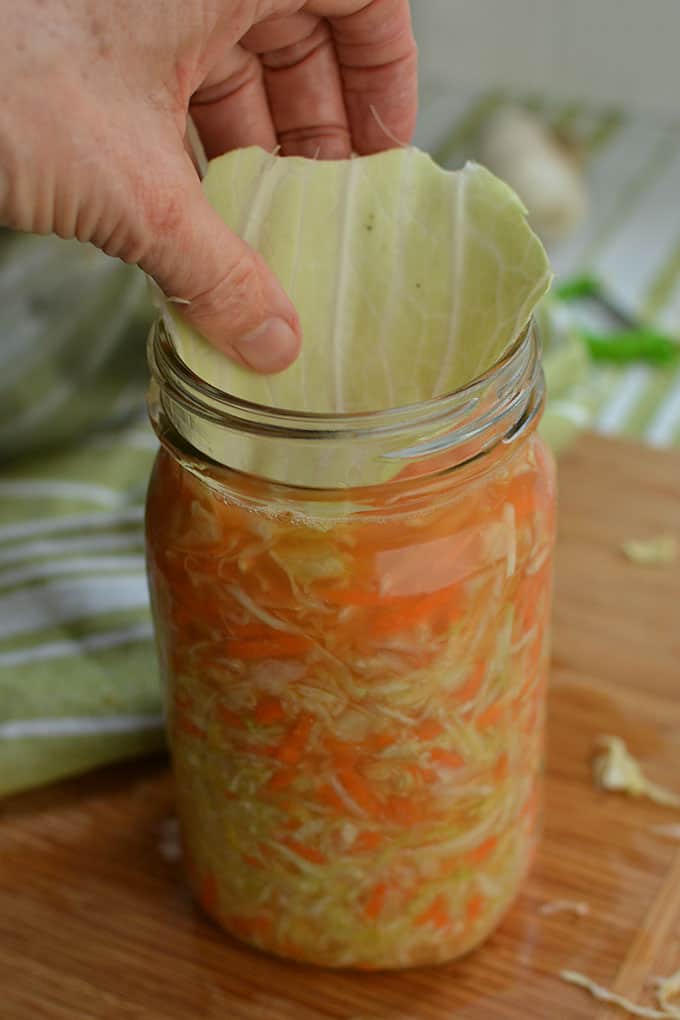
A Fermentation Weight prevents your packed mass of sauerkraut or loose vegetables from working themselves up and out of the jar.
The fermentation process creates carbon dioxide (co2) gases that have to go somewhere. With loose vegetables – as in pickles, the bubbles easily work there way around the vegetables and rise to the surface. With a packed mixture – as in sauerkraut – this can be made more difficult, especially if packed super tight. What can happen instead is that co2 gases accumulate in the packed sauerkraut and the mixture bulges and is then pushed up and out of the brine.
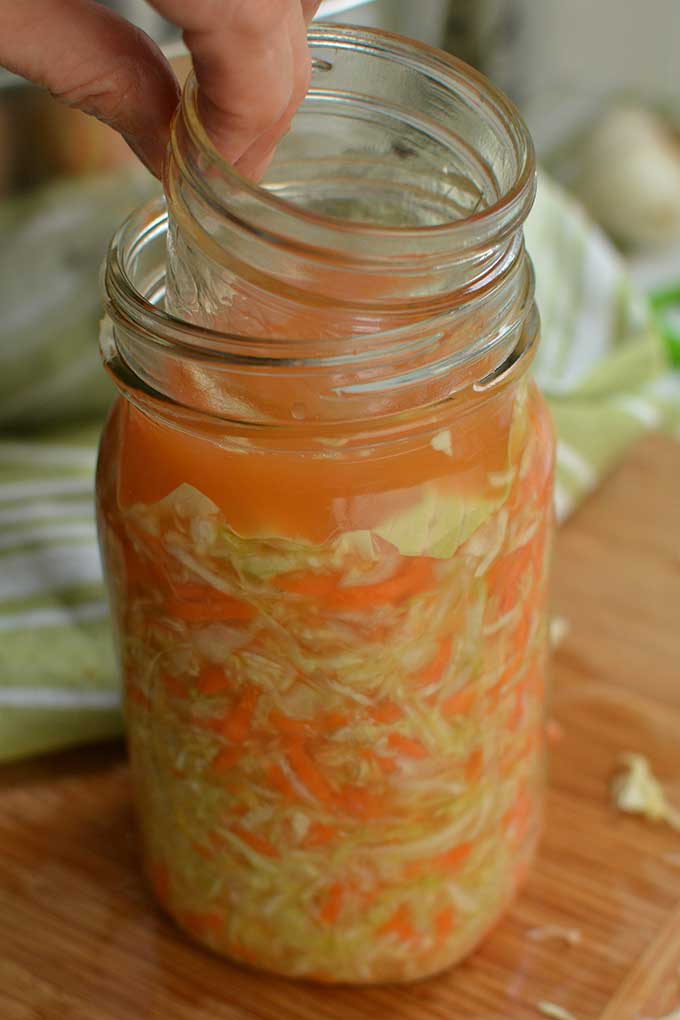
A Fermentation Lid dramatically decreases air exposure. You can use a simple plastic lid, the lid and rim that came with your jar, or a lid with an airlock.
In 9 TOP Fermentation Lids for Mason Jar Fermentation [HOW AIRLOCKS WORK], I cover the various types of fermentation lids.
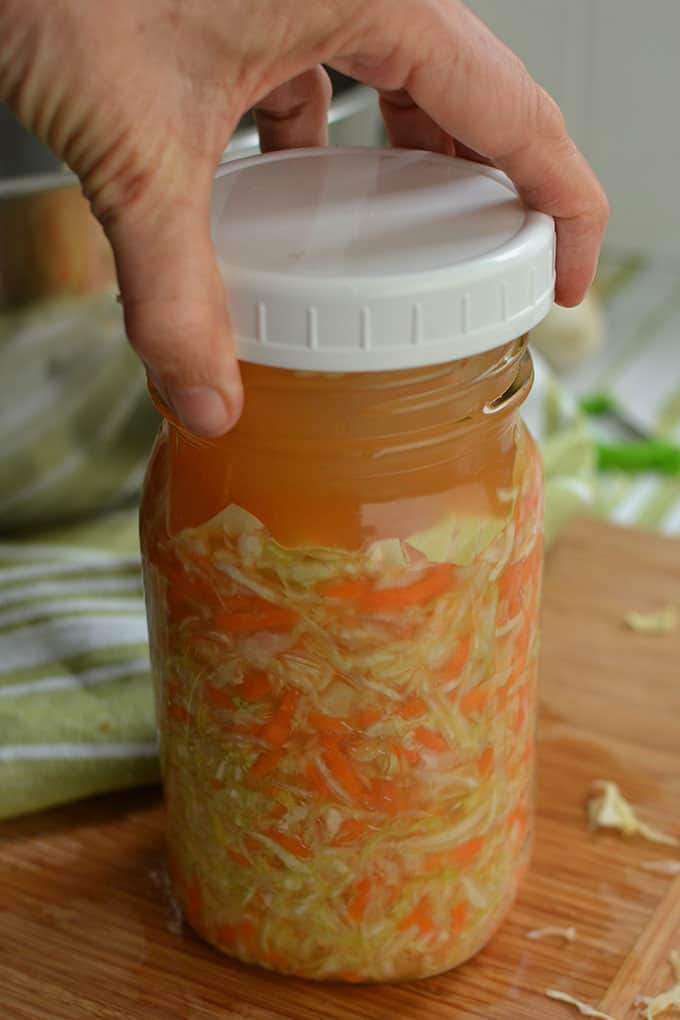
Keep these fermentation tips in mind and soon you’ll be consistently making mouthwatering sauerkraut with ease.
Why Keep Everything Below the Brine?
Before I give suggestions for floaties traps and fermentation weights, let’s first understand the role that the trillions of bacteria in our fermenting vegetables or sauerkraut play. It’s important to understand how the many armies of microscopic friends and foes that live with us do their jobs.
There are countless armies at your disposal. Put out the welcome mat for the friendly armies by using the right amount of salt, fermenting at the right temperatures and keeping everything below the brine.
Friend or Foe?
The good bacteria – or the friendly armies – are:
- The friends that give our sauerkraut its tang.
- The friends that make carbon dioxide to keep air out of our jar.
- The friends that make lactic acid to preserve our ferment.
- The friends that eat the sugars in our fermenting vegetables.
- The friends that make our sauerkraut, oh so flavorful.
The “bad” bacteria – or the mold and yeast armies – are:
- The foes that grow bluish, greenish or grayish furry stuff on the surface of your ferment.
- The foes that leave a white powder in their wake.
- The foes that turn sauerkraut soft and slimy.
- The foes that make you fear eating your ferments.
Mold
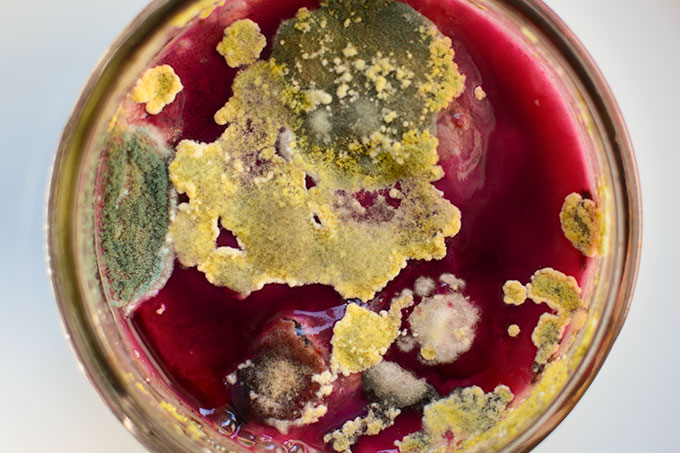
That bluish, greenish or grayish furry stuff is mold. This image is from a neglected batch of fermented beets.
“Mold is a fungus organism that grows in filaments that are connected, so it’s a thread-like type of creature that’s multi-celled in contrast to bacteria which is a single-celled organism.”
“Mold grows from mold spores that are present everywhere in the air and begin growing when they land on a wet surface that has nutrients (such as your food). They can actually survive in acidic foods so it’s not necessarily the acidity that deters them.”
“There is no reasonable way to eliminate mold spores when it comes to removing them from a human environment so you’re always going to be in the presence of them. They only become a problem when they begin to multiply.”
– Fermentation Podcast: 5 Questions on Mold and Food Safety
Kahm Yeast
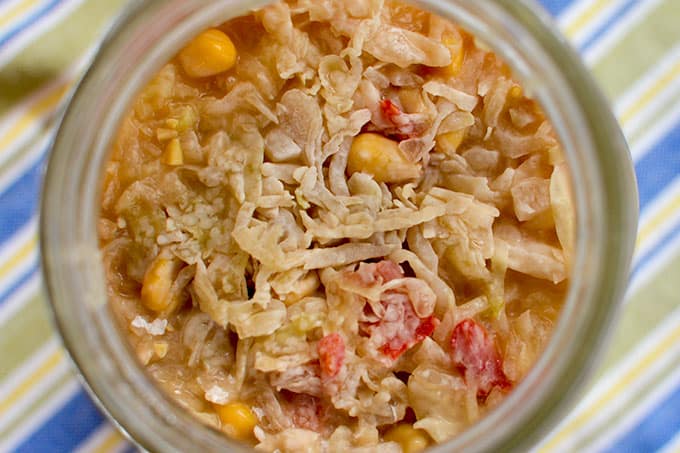
Mold is different from Kahm yeast. Kahm yeast is a smooth, harmless surface powder that grows on ferments that haven’t reached high enough acids levels. It’s a hassle to deal with and can impart an off-taste. So, we don’t want to enable the Kahm Yeast Armies to move in either.
We don’t want the Mold Armies hanging out on the surface of our sauerkraut, but if you leave a little bit of cabbage, grated carrot or pepper chunk floating on the top of your ferment, like it or not, chances they are going to jump on board, just as a frog will jump upon a lily pad. Or, if there is a lot of air at the top of your jar or crock, the Kahm Yeast Army is going to invade.
For more on what might be growing in your ferment:
Has Your Sauerkraut Fermentation Gone Bad: 3 Fermentation Rules and Many Troubleshooting Tips
How do we prevent this?
With a floaties trap, fermentation weight, and fermentation lid.
What Type of Materials Can Be Used for a Floaties Trap and Fermentation Weights
When selecting items to use a floaties trap or for fermentation weights in your ferment, there is a whole range of options, some food-safe, some not. It is not ideal for some food-safe items to be used long-term in an acidic environment.
I’ll briefly discuss each choice and then it is your call on whether or not you use that knick-knack found at the back of your junk drawer as a Floaties Trap or fermentation weight.
Different materials that your trap or weight can be made of and considerations to bear in mind:
- Vegetable Matter. Your safest bet for a Floaties Trap. I almost always use a cabbage leaf.
- Glass. Items made from glass are my first choice when selecting a fermentation weight. Canning jars – like the mini jelly jar I recommend – meet the same quality standards as the jars you ferment in. They are food safe even for acidic foods. And now, there are glass fermentation weights available for purchase that are made from the same glass used in canning jars. Do you care where the item is made? Some avoid all glass from China, not being comfortable with their safety standards. It is hard to know the safety of non-food glass items such as marbles or Glass Floral Gems, all which I used as weights early on in my fermentation journey.
- Stainless Steel. Marine-grade stainless steel does not react with the acids in a ferment react.
- Copper or Brass. Do not use items made from copper or brass. They can leach into the ferment and, in addition, can themselves be destroyed by the acid and salt from the fermentation process.
- Plastic. So handy but such an unknown. But again, I’ve used many a plastic yogurt lid cut to size.
- Silicone. Silicone is considered food safe. However, I have seen no studies on its use in an acidic environment.
Remember, we all have different thresholds for what we’ll use and are all in a different place on our fermentation journey. Enjoy the journey and up the quality of the materials you use as you have the mental and financial space to do so. No guilt trips.
What to Use as a Floaties Trap
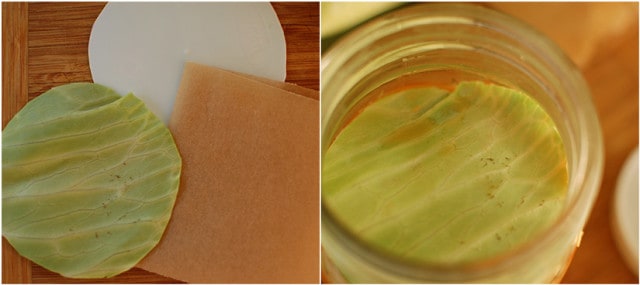
And now some suggestions for what you can use as a Floaties Trap in your ferment.
Cabbage Leaf Torn to Size
A clean outer leaf from your cabbage, torn to size, makes for a great Floaties Trap. It’s definitely food safe and readily available. After all, you are most likely making a batch of sauerkraut and should have an available cabbage leaf.
If you are obsessive, use the rim on your jar to firmly press on the leaf, leaving a ring print which you can then tear or cut into a perfect circle.
If you’re fermenting in a large crock, you will have to overlap a few large cabbage leaves to cover your ferment.
However, sometimes we forget to save a cabbage leaf or perhaps we’re fermenting something else. Some other options.
I have read of carrot peels, crisscrossed like spokes of a wheel, being used as a floaties trap. Or, thin slices of a large radish or other vegetables.
Parchment Paper
Use unbleached parchment paper – the brown stuff – so you are not introducing bleaching agents into your sauerkraut that could interfere with the fermentation process. Unbleached parchment paper can be found at most health food stores.
Tear off a strip the width of the opening for your jar and then fold to size.
For a crock, cut a large circle of parchment paper to size.
Piece of Clean Cloth
One of my readers alerted me to another idea for a Floaties Trap. Thank you, Wayland.
Fold or cut to size a piece of clean cloth, muslin or cheesecloth.
Food-Grade Plastic Lid
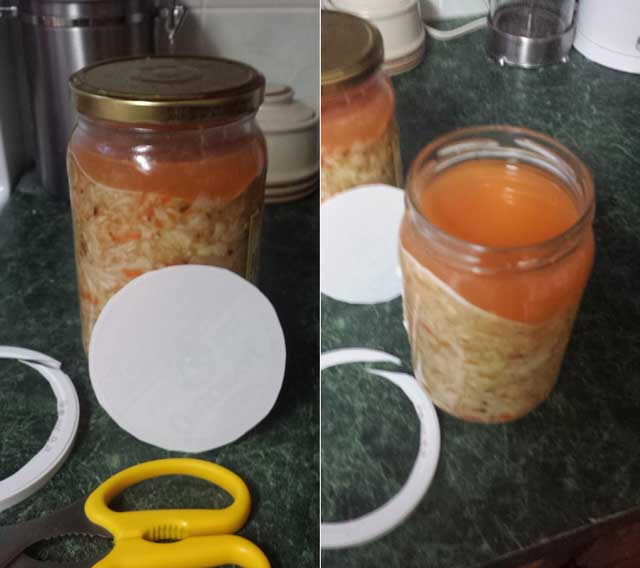
In a pinch, I’ve used a yogurt lid cut to size. It works like a charm. Some are not comfortable with plastic being used long-term use in an acidic environment.
And, as you can see in the pictures above, a plastic lid cut to just the right size can serve as both a Floaties Trap and a fermentation weight. It works great for all jar sizes. Pictures above and instructions below thanks to Rob, one of my readers in Canada:
- Take a plastic yogurt or margarine lid bigger than the inside of the jar being used.
- Cut along the edge of the lid with good scissors to keep it round, rather than measurement perfect.
- Rinse in diluted bleach for a few minutes. Rinse well.
- Force the plastic into the jar on top of the kraut. Trim if too large. Start again if too small. It should hold on to the sides of the jar quite tightly.
And, what I like about this idea is that there is plenty of room for brine.
For a crock, the right sized plate or a larger plastic lid can also work as a floaties trap.
Pringles Lid – From One of My Readers
“If anyone needs A quick and easy floaty trap, a plastic lid off a Pringles potato chip can work really well. It’s a perfect size. Place flat side down. It’s all I use anymore.”
Thanks, Dean!
Dehydrator Screens
I ordered a set of Excalibur dehydrator screens just to make Floaties Traps for fermenting. The Excalibur company prides themselves on quality. Their dehydrator screens are made in the USA, use FDA approved food-grade materials, and are BPA-free. Again, if these are cut to just the rights size, they can serve as both a Floaties Trap and a fermentation weight.
The screen holes in this material, allow brine and co2 gases to easily move upward in your jar or crock.
The Excalibur screen is 14″ square which is large enough to cut down to size for a crock.
Silicone Sealing Lid Liners
Silicone Sealing Lid Liners. You may have a silicone item in your kitchen that you don’t mind cutting to size for a Floaties Trap.
The Mason Jar Company sells food safe silicone lid liners designed specifically for use inside Ball plastic storage caps and other lids for wide-mouth canning jars. If they are too big to fit down inside your jar, trim to size.
I have yet to try these. One reviewer complained of a smell she could not get rid of. The company recommends soaking the lids in a baking soda and water solution to remove the odor.
Now that you have a way to prevent little pieces of vegetable matter from floating to the surface where the Mold Army can invade, I share some ideas for fermentation weights.
What to Use as Fermentation Weight
First, some things to keep in mind when deciding what type of fermentation weight to use:
- Where are you on the food-safe spectrum? Are you OK with plastic? Do you care if the material you use is made in China?
- Do you prefer the DIY route or would the purchase of a few weights designed specifically for fermentation make your day? With new fermentation products entering the market almost daily, you can quickly spend a few hundred dollars. Would you rather put that money towards a fancy-schmancy water-sealed crock that takes fermentation to a whole new level? Or, are you perfectly happy with collecting what you need for the single-jar method?
- How many jars do you have going at any one time? Will $25 spent on a few weights be all you need?
- What’s the weight of the fermentation weight? You may find that some of the glass weights are not heavy enough to hold a very active ferment below the brine.
- What’s the size of the weight and can it fit into your jar? Weights designed for fermentation work well with wide-mouth jars but won’t fit into narrow-mouth jars.
- How about using a chunk of vegetable? Some recommend using a cabbage core or other chunk of vegetable. The problem I see with this is that a portion of the vegetable is above the brine and exposed to air. A perfect place for mold to grow.
Small 4-Ounce (125 ml) Jelly Jar
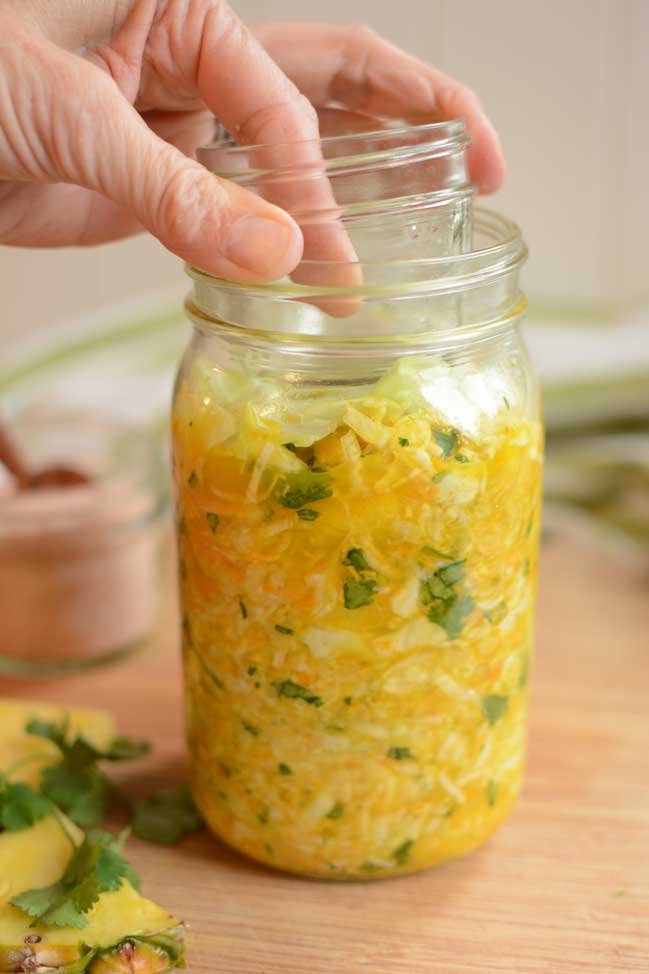
I have found this to fit the bill… almost. The main drawback is that the small jar does take up space I would rather leave for brine. This little jar – or other similar containers – work more as a counter-force than a weight. As the sauerkraut pushes up on the little jar, it’s held in place by the lid and can go no further, thus remaining below the brine.
Here are some other types of small jar-like-items that can serve as fermentation “weights” or a counter-force:
- Shot Glass
- Baby Food Jar
- Espresso Cup
- Condiment Dish
- Stainless Steel Portion Cup
And, if you don’t mind leaving the lid off your ferment, a jar filled with water and its lid screwed on works like a charm.
Zip-Lock Bag Filled with Brine
This is a common no-cost method. Start with an empty bag, open and press down on your ferment. Then, fill with brine and seal. It can get a bit messy when brine finds its way up the side the of the bag.
Cleaned Rock or Stone
Comb the beach for a stone the right size to fit in your jar. Stay away from limestone since it can interact with the acids in your ferment. Boil for 15-20 minutes before first using to kill any harmful bacteria.
Other Small Found Household Items
Place any of these small items in a cotton tea bag or mesh bag. Or, leave loose and pick out one by one.
- Marbles. You’ll want lead-free marbles without paints or glazes that could leach into your ferment.
- Glass Floral Gems. I used these for years and then switched to the small jelly jar. They can be a bit light and it’s hard to know the quality of the glass.
- Ceramic Pie Weights. These are food-safe and should be heavy enough to hold down your ferment.
- Whiskey Stones. Again, food-safe and heavy enough to hold down your ferment.
The Daily-Fork Method
Monitor your ferment daily and when you see it bulging above the brine, open the lid and press the contents down with a fork.
I prefer not to disturb my ferment like this and do realize it introduces a new batch of air into the ferment each time you open the lid. But, for the fiddly type, it can work well.
Best Fermentation Weights to Purchase
There are a wide variety of fermentation weights currently available in a range of styles. They are all designed to keep your ferment below the brine, though some do a better job than others. They are made with either break-proof glass, marine-grade stainless steel, food-safe silicone, or food-safe plastic with each material coming with their own set of pros and cons.
In the table below, I show some of the best. In the sections that follow, I group them into three styles of fermentatation weights and share the pros and cons fo each.
Fermentation Weights
A fermentation weight relies upon weight to hold your ferment below the brine.
Most all are made from made from non-iridized soda glass (the same material glass canning jars are made from), a lead-free material that guarantees nothing will leach into your ferment.
Common complaints from users are that they break and some can be difficult to remove from the jar, hence the “handles” on the newer designs.
The major drawback is that they don’t have enough weight to always hold your ferment below the brine for the 3-4 week duration of a ferment. However, they seem to keep your ferment below the brine during the critical first week of fermentation.
- Effortless Handling: Experience the ease of using our redesigned glass fermentation weights....
- Universal Compatibility: Our weights are tailored for all wide mouth mason jars. Ideal for...
- Superior Quality: Crafted from thick, crack-proof glass, our weights ensure durability and...
- GET A GRIP: The handle has a lip on the top edge that makes it easier to grab, whether it’s...
- KEEP YOUR VEGGIES DOWN: With an average weight of 6.5 ozs, these weights are heavier than most,...
- STAY SAFE: Food safe, non-porous, lead-free, gluten free, non-GMO (ok, now we’re just being...
Fermentation Springs
A fermentation spring relies upon the pressure from a coiled spring to push your ferment down under the brine. These are being made from high-grade stainless steel.
The Kraut Source fermentation lid uses a spring made from a light grade of stainless steel along with a stainless steel plate to push down on your ferment. The The Pickle Helix uses a spring made from a heavier grade of stainless steel that is tightly coiled at the bottom to push down on your ferment.
The Pickle-Helix springs can also be purchased without the lids.
- INCLUDES: 3 x Pickle Helix Stainless Steel Fermenting Coils (lid & jars not included). BONUS -...
- FERMENT LIKE A PRO: Pro fermenters use nothing but stainless steel why shouldn’t you? The...
- VERSATILE: The Pickle Helix Coil self-adjusts to work with any size mason jar for fermentation....
- Makes fermenting foods like sauerkraut, pickles, salsa, kimchi and more fun and easy.
- It fits on standard wide-mouth mason jars*, allowing you make pint, quart, or half-gallon sized...
- Specially designed to keep air out and fermenting fruits and veggies submerged in brine.
Fermentation Gates
A fermentation gate is a device locked into the neck of the jar to prevent your ferment from moving upwards in the jar or “heaving.” These are usually made from food-safe plastic or silicone.
The plastic Canning Buddies has tabs that hold it in place in the neck of the jar. The silicone Pickle Pusher also has tabs that secure it in place in the neck of the jar. And the small canning jar I use in my teaching recipe relies upon the lid to hold it in place. There is also the plastic No products found. – with gripping teeth on its bottom and a slit on its side for brine seepage – that acts as a fermentation gate.
The challenge when using a fermentation gate is to pack the jar to just the right height. Too high and you have “brine overflow.” Too low and the fermentation gate can’t apply its force. With the ViscoDisc, I pack my jar with the usual amount of cabbage and then push the Canning Buddies down into the neck of the jar. It works splendidly as seen in my review post on the ViscoDisc Canning Buddies.
My in-depth review of the Pickle Pusher can be found here. It is available both on Amazon and on the company’s website.
- 1 Fermenting kit with airlock & Pickle*Pusher weight system. Holds 25X more than fermenting...
- Pickle*Pusher weight replacement system is BPA free foodsafe silicone & 316 stainless steel
- All lids & airlocks are BPA free foodsafe plastic. Gaskets & grommets are BPA free foodsafe...
Porcelain or Ceramic Fermentation Weights
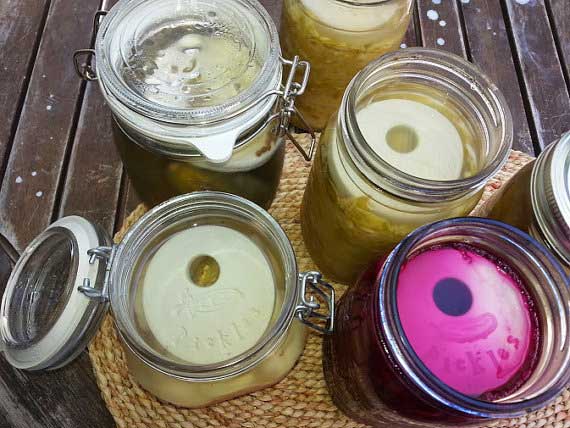
Pottery by Sandy Der Etsy Shop. Unglazed porcelain. Low absorption, like glass. They are made of unglazed porcelain and fired to 2160F. Non-porous and resists stains. Dishwasher safe.
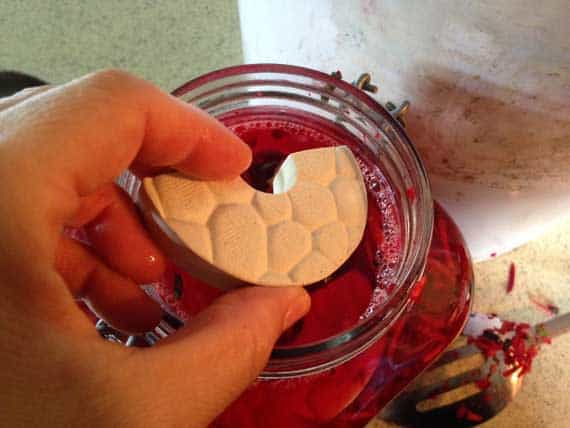
Tamarack Stoneware Etsy Shop. Made of high-fired, fine-grain stoneware clay.
Since these are a 2-piece weight, they can be cut a bit bigger than the single piece weights thus allowing for complete coverage of your ferment. They weigh 6 ounces (170 g), similar in weight to some of the glass weights.
Note: Stoneware clay is porous. Porous weights work great, just make sure they are completely dry before storing, else mold can grow on them.
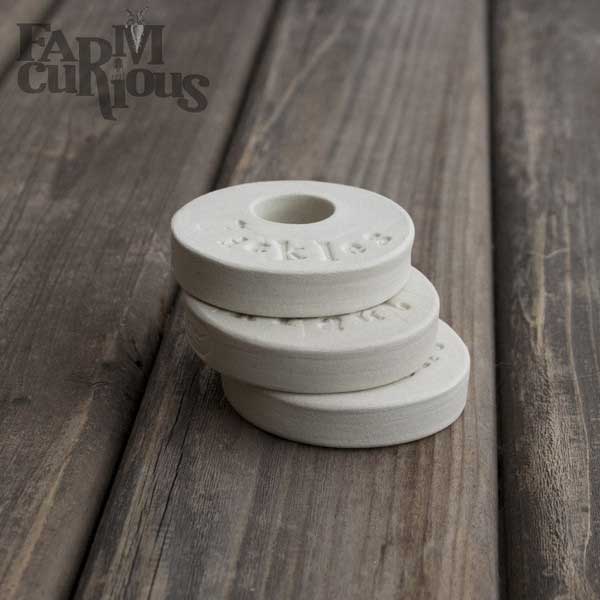
Farm-Curious Fermentation Weights. Handmade porcelain weights are ideal for keeping your fermenting veggies submerged under brine and are made in three sizes to fit any Mason jar.
Fermentation Weights for Crocks to Purchase
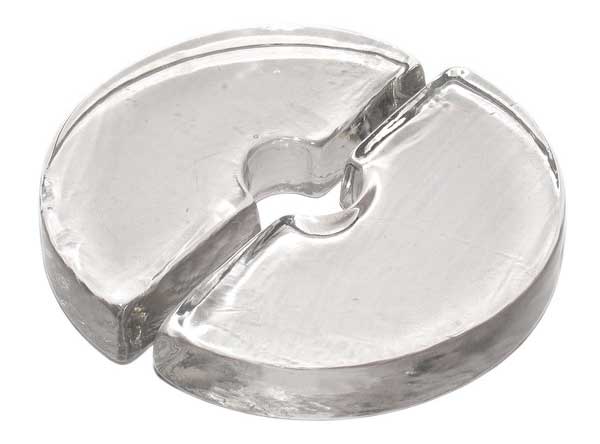
Most crocks come with weights, especially the water-sealed fermentation crocks that make it oh-so-easy to successfully ferment sauerkraut. I talk all about them in this post:
Fermentation Crocks: The Who, What, Where, When, Why and How
and discuss how to ferment in a crock here:
The SureFire Sauerkraut Method: In a Crock: 7 Easy Steps
If you need fermentation weights for your large crock, I highly recommend the lead-free glass weights sold by Stone Creek Trading as an alternative to the traditional porous ceramic weights which are sold with most fermenting crocks.
From their website:
“With traditional ceramic porous weights, the unglazed surface can absorb bacteria present in your ferment. When something goes wrong in the fermentation process, the bad bacteria or mold can be absorbed into the porous stones. It can be very difficult to then sanitize the porous stones. As an alternative, glass is non-porous and will not absorb anything!”
In addition to being non-porous:
“Luna Glass Crock Weights are 15% heavier than the traditional porous weights. The additional weight helps keep your ferment submerged where you want it.”
I’m excited to try a set of these. From one review:
“Glass weights are great as they don’t absorb odors or stains and allow you to see food beneath.”
Below the Brine and All Is Safe
Use these fermentation tips to keep your ferment safe from the Mold Armies and the Kahm Yeast Armies. In addition, use the right amount of salt and ferment for the right length according to your fermentation environment and all will be good:
How Much Salt Do I Use to Make Sauerkraut?
How Long To Ferment Sauerkraut?
And do share in the Comments your preferred method for a Floaties Trap or fermentation weight along with sharing any I may have missed.
Last update on 2024-04-18 / Affiliate links / Images from Amazon Product Advertising API

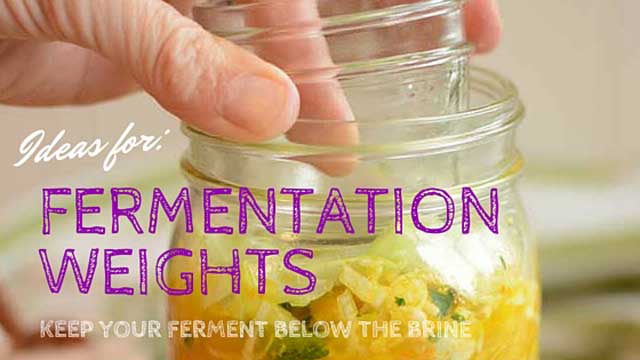

 This post may contain affiliate links which won’t change your price but will share some commission.
This post may contain affiliate links which won’t change your price but will share some commission.